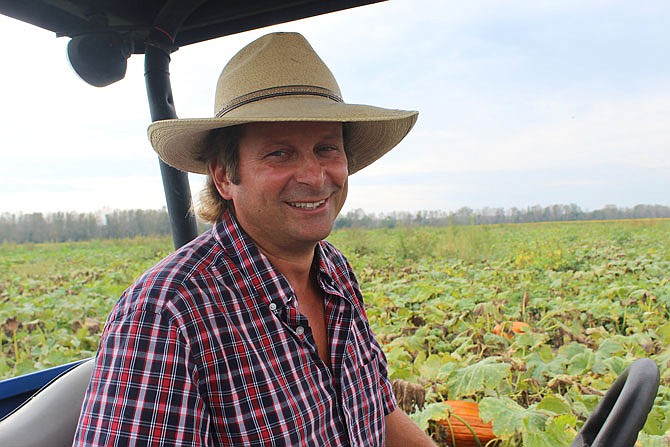CALLAWAY COUNTY, Mo. - It's the heart of harvest season at Fischer Farms, but you won't see any combines in this pumpkin patch.
Instead, human hands work their way through the ranch's 40 pumpkin acres.
"There is mechanical harvesting for pumpkins, but it's for canning," said Jay Fischer, who owns and operates the farm with his wife, Kim, and daughter, Jena. "For our type of pumpkins, we hand-harvest only."
Whether you can machine harvest depends on the pumpkins' destination. Machines may be quick and efficient, but they tend to break pumpkins on occasion.
Because Fischer pumpkins are sold intact and often used in decorating, it's important to keep them attractive. That means no mechanical harvests.
At picking time, the Fischers and their farmhands first cut them from the vine with a sharp knife or pruning shears. Typically, one worker concentrates on that cutting job, while another follows and picks up the pumpkins.
It's a system similar to picking watermelons or other large crops hand-picked from vines.
As for hand-harvesting, that method is common statewide.
"Almost all or all of pumpkins grown in Missouri are sold whole for final purchase by a retail consumer," James Quinn, a University of Missouri Extension horticulture specialist, said. "Most are for ornamental (purposes), but there are always some pie pumpkins and specialty types which are preferred for cooking."
A few hours northeast, Morton, Illinois, is known as the "pumpkin capital of the world" for producing roughly 85 percent of the globe's canned pumpkin. Because they're headed to factories rather than stores, keeping them pretty isn't worth the trouble of hand-harvesting. That means machines are in the fields.
Growing conditions
The Fischers planted pumpkins around June 20. A couple weeks later brought a 3-inch rainfall. When those wet conditions caused the ground to crust before the crops could sprout, they had to loosen the soil with a rotary hoe.
"It impeded our stand a little bit," Fischer admitted.
Other farms suffered even more troubled starts. In some areas, heavy rain events in May and June caused streams to flood into fields, Quinn said.
More rain fell generously in August but hardly at all in September. That meant the Fischers' earlier-set fruit looked great by then, but their later-set crops were troubled.
As for cooler-than-normal August temperatures, the pumpkins certainly benefited.
"Pumpkins do good in cooler weather," Fischer said. "It was probably good for them not to have too much heat."
He pointed out an anecdote: Think of the last time you heard about a giant pumpkin that broke records for weight. Chances are, it was grown in the chillier Northeast.
Another challenge for growing in Missouri is the humidity. Fischer Farms' location - just north of Jefferson City, off the Missouri River - has its share of it. Those muggy conditions can cause fungal diseases such as powdery mildew and downy mildew. The Fischers compensate by spraying fungicides.
"We had to spray more than we usually do because of all the damp conditions in the river valley," Fischer said.
Quinn, the horticulturist, agreed more water isn't always better for pumpkin growing. And while desert conditions aren't ideal either, a late summer rain break can help.
"Pumpkin varieties are adapted to the summer growing conditions in the Midwest, which are warm temperatures with reasonable rainfall, full sun and good quality soil," he said via email. "Having a slightly dry period during the fruit ripening - late August through September - is good, as too much moisture can cause fruit to rot. For much of Missouri, the conditions were good and growers who had a good stand have mostly ended up with a decent crop."
Varieties
When you picture a pumpkin, you probably image a fruit that's bright orange and fairly round. Now, get a bit more creative with that image. There are many varieties of pumpkins and squash; those crops can be found in all shapes and sizes.
The Fischers grow about 10 varieties. Sizes range from mini pumpkins - just a few inches wide - to 60-70-pound monsters.
And while some may think of pumpkins as either edible or ornamental, those qualities are not mutually exclusive. Certain varieties such as Cinderella can be both, Quinn said. Their lengthy shelf life helps them serve both purposes.
"Folks should consider displaying these through Halloween and then eating them later," he said. "They can sit out for quite some time and still be fine to cook."

